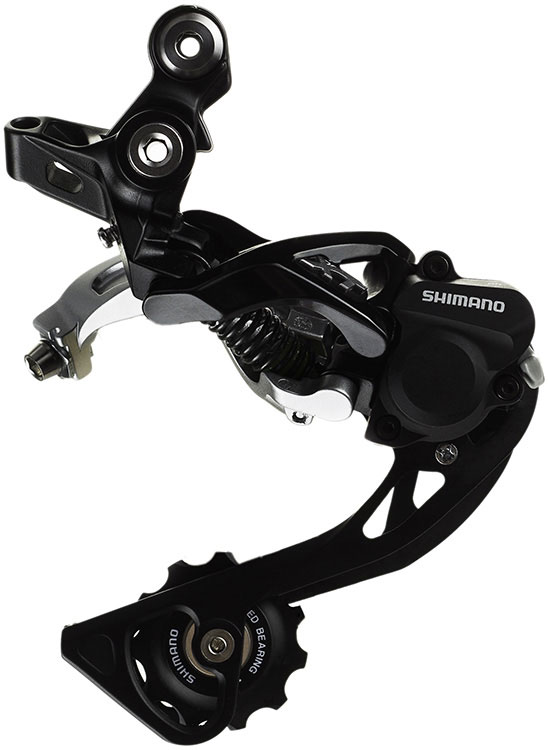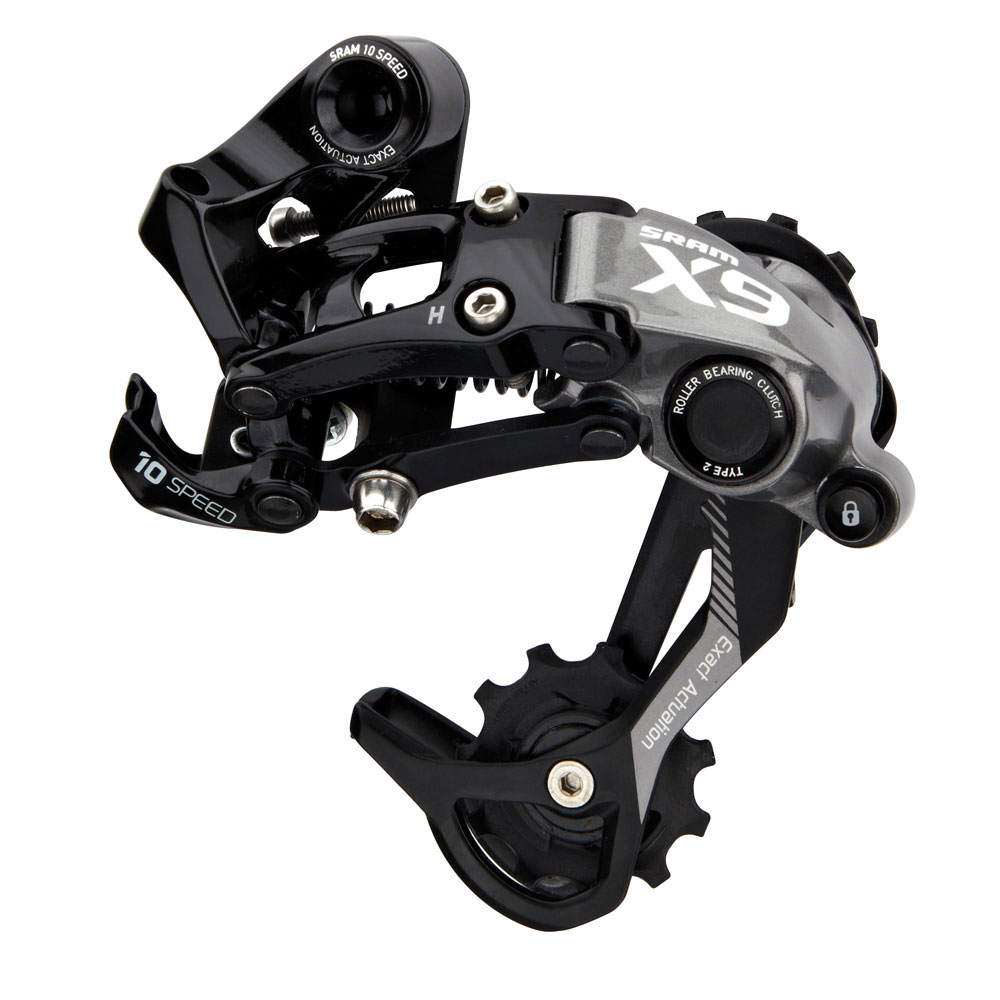 Products: Shimano XT and SRAM X9 Clutch Derailleurs
Products: Shimano XT and SRAM X9 Clutch Derailleurs
Shimano XT
10 Speeds
Weight: 258g
Tested on: Specialized SX Trail; Turner 5.Spot
MSRP: $140
10 Speeds
Weight: 250g
Tested on: Specialized SX Trail
MSRP: $116
When 10-speed drivetrains for mountain bikes came out I, like a lot of other people, thought, “Meh, what does one more gear really do for my life?”
After all, a lot of us are old enough to remember when 9-speed systems came out, and the crappy early chains that came with them that left our crotches on our top tubes when they would break under a sprint.
And a few of us are even old enough to remember when 8-speed systems came out, and buying new hubs sucked, and all we got was another reason to pedal uphill slower.
And some of us are just old grumpy bastards who hate new stuff….
But then something interesting happened: friction clutches on derailleurs.
Chains on multi-speed mountain bikes flop because of derailleurs, simple as that. Derailleurs act as tensioning devices, and there’s a degree of freedom dictated by the strength of their spring. Regardless of what an engineer at Shimano or SRAM comes up with as an acceptable balance of shift resistance and “flop retention” (no, seriously—that’s an industry term), there are going to be multiple scenarios where you and I are hitting sections of trail that shake that little derailleur cage all over the damn place.
Chains are steel. They’re heavy. It takes a lot of spring tension to keep them from bouncing. But what if we used a damping system based on friction instead of just raw spring tension?
Eureka! The paint on your chainstay is saved! And more importantly, you can now silently sneak up on dudes in thin, ripstop short shorts speed walking with power poles.
This more than anything else piqued my interest in 10-speed setups (the dudes in short shorts I mean). And I’m far from alone on this. The conversation of 10-speed clutch derailleurs being used with 9-speed systems has become a pretty common one. As in, “I want a clutch derailleur, but why should I spend all the money on additional shifters and a cassette?” Hold tight, I’m about to tell you why. Because it’s really the biggest reason to switch to a 10-speed setup.
The Crappy Part
With 10-speed systems comes a new parallelogram from both of the big two that moves the derailleur in an entirely different way than 9-speed systems. I tried it. It “kinda works,” at best. As in, I’d be fine getting out the woods with it, but there’s no way I’d roll a bike out of my garage with a 10-speed derailleur with 9-speed shifters and cassette. Skipping your chain sucks and causes boo-boos. You will end up with a crippled bike if you try this. Don’t do it.
If you remember the first wave of 9-speed chains, guess what! 10-speed chains bend easier, too! I measured some plates of 9-speed links and 10-speed links, and they’re the same thickness as far as I can tell (about 0.95mm). The only thing I can think of is that the 5.75mm width of an entire outer link (vs. 6.50 for a 9-speed) is less structurally sound with regards to lateral forces. It’s like taking a bowlegged cowboy and making him stick his ankles together. That ain’t no fightin’ stance. Just narrowing the chains in itself makes a weaker parallelogram…it’s science. It may not be the plates themselves, but I do know that the first 10-speed setup I had experienced two bent chains. I don’t even know where or why it happened. I don’t remember anything unusual in a shift, but my chain started skipping. When I went to see what was going on, my chain was bent…in both instances.
A good friend of mine who is one of the most technically proficient bike riders I’ve ever met actually bent one in a race on a course he literally used to live at the bottom of. Neither of us bend chains. When we went to 10-speed setups…we bent chains. I’ve been a little more conscious of my shifting, and it hasn’t happened again, so we may have just been riding like hacks. But I’m convinced there’s something going on with the narrower chains and/or the tighter gear spacing that makes this a potential issue.
If you’ve ever ridden a dialed road bike with tight gear spacing, you can appreciate the small gaps between gears. It just feels so much more smooth and refined. Riding road bikes is boring, however, and it leads one to geek out on mundane things like “smooth, tight gearing.” When I shift gears on a mountain bike, it’s because I want a significantly different amount of resistance—and soon. I actually find the tight spacing kind of annoying, and the thought of dammit, gimme another! is kind of a regular occurrence.


Agreed, Since using Shimano’s new Shadow XT Plus RD I’ve been floored by the difference. I too am back buying Shimano components after a enjoyable past few years on SRAM.
Any readers got an opinion on the Zee Shadow Plus (clutch) rear mech? It’s the cheaper version of the Saint, short cage but can accommodate an 11-36 cassette which I’m considering for my 1×10 AM bike. Or would it be better to stay with an SLX if looking for an affordable clutch derailleur?
A friend just got the Zee rear derailleur for the same setup (160 travel bike setup 1×10). He’s had it for a few rides now and seems to like it. I pedaled around the parking lot and it felt pretty good. I’m considering getting the Zee setup for my SX Trail.
Lorne,
I have one and I like it. It’s on an 11-36 Shimano cassette, w a 32 ring up front on my trail bike. I have it with the Saint shifter, which is sooooo slick. it’s the best part of the system, hands down.
I must be missing something here… I run 1×10 with a medium cage XT dérailleur and don’t get any chain noise or chain slap against my frame (I’ve had people try my bike and remark on how silent the drivechain runs). There’s no chain guide, just a cheap BBG bashwhich and an correctly-sized chain for my chainring/cassette combo.
Is clutch designed for double or triple chainrings where it’s possible to get loads of loose chain when running in the smaller chainring? It just doesn’t seem relevant to my 1×10 setup.
If you’re not getting a bunch of chainslap and you can keep your chain on without a guide, then I don’t see a reason to bother with buying a clutch setup. That’s a unique combination you have though, it’s certainly not the norm (hence the remarks from your buddies). As far as single vs. multiple ring setups, I’ve run them on 1×10 setups and 2×10 setups and both benefitted greatly from the new derailleurs, trail bikes and dh bikes alike.
In response to Zack’s comment. Not all bikes running these various system suffer from the same issues. Factors such as chain length, B-Tension screw setting and frame design play a role. Example: FSR type and Giant Reign type frames make a hell of a racket. Whereas Trek Remedy is relatively quiet. Chains that come on the bike are often too long IMO. They are the spec’d length but essentially they allow for poor shifting technique (basically cross shifting) without risk of damaging the drivetrain or frame when the suspension compresses. Shift big ring to big cog and lean on the saddle while looking at the rear derailer and you’ll see what I mean. I like short chains, sometimes we swap for a longer B-Tension screw and use it to over crank the spring tension. Keeps stuff pretty quite. =)
Great review! Thanks.
So why even bother ever taking the clutch off? Why not just design the derailleur to provide the clutch function set to on all the time? By reading some reviews and feedback commwents it obviously work well, but i dont get what the benefit will be switching it off.
There’s more resistence on downshifts, enough that it’s noticeable. Not a big deal but it is more effort and on those death grind kinds of rides where you get back to your car with the stars twinkling and two hours out of water sometimes you just need life to be easy.
But mostly it just makes it easier to take the wheel off.
Hello,
The new X9 (with ball bearing start from 2012) car upshift up to 3 gears at once…